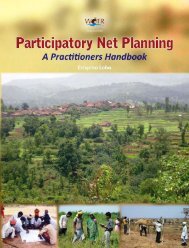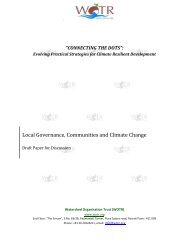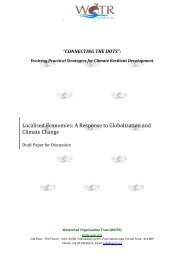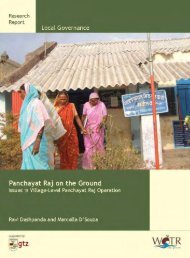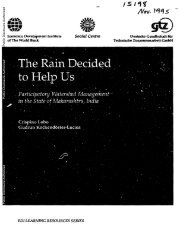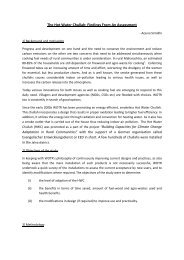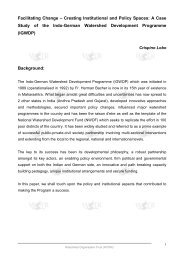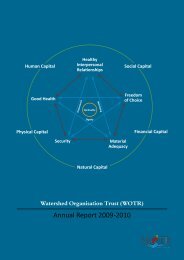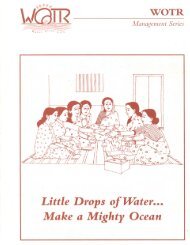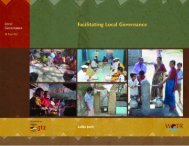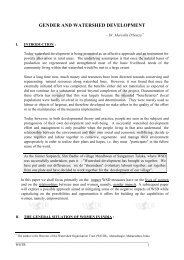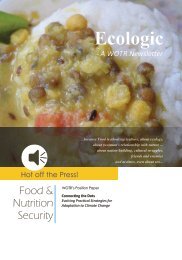INDO-GERMAN WATERSHED DEVELOPMENT PROGRAMME : - wotr
INDO-GERMAN WATERSHED DEVELOPMENT PROGRAMME : - wotr
INDO-GERMAN WATERSHED DEVELOPMENT PROGRAMME : - wotr
Create successful ePaper yourself
Turn your PDF publications into a flip-book with our unique Google optimized e-Paper software.
<strong>INDO</strong>-<strong>GERMAN</strong> <strong>WATERSHED</strong> <strong>DEVELOPMENT</strong> <strong>PROGRAMME</strong> :<br />
MACRO-MANAGEMENT FOR MICRO COOPERATION<br />
INSTITUTIONAL ARRANGEMENTS AND IMPACT OF PARTICIPATORY<br />
NATURAL RESOURCES MANAGEMENT<br />
Paper presented at<br />
DSE / ATSAF Workshop<br />
on<br />
Strategies for Intersectoral Water Management in Developing<br />
Countries<br />
- Challenges and Consequences for Agriculture -<br />
MAY 6 - 10 , 1996<br />
Berlin, Federal Republic of Germany.<br />
CRISPINO LOBO<br />
AHMEDNAGAR, MAHARASHTRA<br />
INDIA
TABLE OF CONTENTS<br />
INTRODUCTION....................................................................................................................3<br />
1. THE BACKGROUND.....................................................................................................3<br />
2. THE PROBLEMATIC....................................................................................................4<br />
3. THE RESPONSE.............................................................................................................5<br />
4. THE CHALLENGE OF SCALE : FROM ONE TO THE MANY.............................8<br />
A) ASSUMPTIONS AND PREMISES.....................................................................................8<br />
(i) Concerning The Operational Milieu..........................................................................8<br />
(ii) Concerning the Organisational Milieu :..............................................................10<br />
B. THE ORGANISATIONAL FRAMEWORK :..........................................................................10<br />
(i) Overview ..................................................................................................................10<br />
(ii) Organisations / Institutions Involved: .................................................................12<br />
5. IMPACT:........................................................................................................................15<br />
A) AT PROJECT LEVEL : .................................................................................................15<br />
(i) On Groundwater, Net Cropped Area, Agricultural Productivity and Livestock.15<br />
(ii) On Human Resources ..........................................................................................16<br />
(iii) On Natural Resources: ............................................................................................17<br />
B) AT INSTITUTIONAL FRAMEWORK LEVEL : ................................................................17<br />
C) AT THE <strong>PROGRAMME</strong> LEVEL : .........................................................................................18<br />
6. CONCLUSION : ...............................................................................................................19<br />
LIST OF ANNEXURES........................................................................................................19<br />
ANNEXURE 1 : OPERATIONAL LEVEL : <strong>PROGRAMME</strong> OVERVIEW -<br />
SECTORS, ACTORS, FUNCTIONS...................................................................................20<br />
ANNEXURE 2 : PROGRAM LEVEL : THE NGO AND PARTICIPATORY<br />
<strong>WATERSHED</strong> <strong>DEVELOPMENT</strong> : SECTORS, ACTORS, FUNCTIONS, OUTPUT,<br />
RESULTS ...............................................................................................................................21<br />
ANNEXURE 3 : OVERVIEW OF THE IGWSDP : INTERRELATIONSHIPS AND<br />
FLOW OF FUNDS ................................................................................................................22<br />
ANNEXURE 4 : ECONOMIC IMPACT OF <strong>WATERSHED</strong> <strong>DEVELOPMENT</strong> IN<br />
PIMPALGAON WAGHA (1988 - 1992)..............................................................................23<br />
ANNEXURE 5 : IMPACT OF THE KASARE <strong>PROGRAMME</strong> - KEY<br />
INDICATORS ( 1989 - 1994)................................................................................................24<br />
ANNEXURE 6 - IMPACT ON OTHER ECONOMIC INDICATORS - KASARE (1989<br />
- 1994)......................................................................................................................................26<br />
ANNEXURE 7 : IIMPACT OF THE MENDHWAN <strong>PROGRAMME</strong> – KEY<br />
INDICATORS........................................................................................................................28<br />
(i)
LIST OF ABBREVIATIONS / ACRONYMS<br />
BMZ Bundesministerium fuer Wirtschaftliche Zusammenarbeit und<br />
Entwicklung (Federal Ministry for Economic Cooperation and<br />
Development)<br />
CBP Capacity Building Phase<br />
CO Community Organiser<br />
COWDEP Comprehensive Watershed Development Programme<br />
DPA Drought Prone Area<br />
FIP Full Implementation Phase<br />
FPC Forest Protection Committee<br />
GoG Government of Germany<br />
GoI Government of India<br />
GoM Government of Maharashtra<br />
GS Gram Sabha<br />
GtZ Deutsche Gesellschaft fuer Technische Zusammenarbeit (German Agency<br />
for Technical Cooperation)<br />
HRD Human Resources Development<br />
IGWSDP Indo-German Watershed Development Programme<br />
KfW Kreditanstalt fuer Weideraufbau (German Bank for Reconstruction and<br />
Development)<br />
KT weirs Kolhapur Type weirs<br />
MISEREOR A German Church related funding Agency<br />
MoF Ministry of Finance<br />
NABARD National Bank for Agriculture and Rural Development<br />
NGO Non Governmental Organisation<br />
PS Panlot Sevaks : Watershed Volunteers<br />
PSC Project Sanctioning Committee<br />
SC Social Centre<br />
SHG Self Help Group<br />
VSHG Village Self Help Group<br />
VWC Village Watershed Committee<br />
WOTR Watershed Organisation Trust<br />
WS Watershed<br />
WSD Watershed Development<br />
(ii)
INTRODUCTION<br />
The Indo-German Watershed Development Programme (IGWSDP) is a bilaterally assisted<br />
Programme being implemented in the State of Maharashtra. While the first agreements were<br />
arrived at in 1989, it was only in 1992 that all formalities were completed. Work, which had<br />
already begun earlier, acquired momentum in 1993. To date the programme is being<br />
implemented in about 85,000 ha. spanning 20 districts of Maharashtra.<br />
The major partners on the German side are the BMZ (Ministry of Economic Cooperation),<br />
the KfW (German Bank for Development) and GtZ (German Agency for Technical<br />
Cooperation), while those on the Indian side are the MoF (Ministry of Finance), NABARD<br />
(National Bank for Agricultural and Rural Development) and WOTR (Watershed<br />
Organisation Trust).<br />
In this Paper, I shall attempt to outline the circumstances and reasons that led to the<br />
initiation of the Programme, the underlying assumptions and beliefs, the issues involved, the<br />
institutional and administrative arrangements arrived at and impacts or results obtained.<br />
1. THE BACKGROUND<br />
Maharashtra, which is the 3rd largest State in India lies on the western coast of India. It<br />
has a population of 78,900,000 people and covers a geographical area of 307,713 sq. km.<br />
Administratively it is divided into 31 districts covering a a total number of 43020<br />
villages.<br />
Geographically Maharashtra consists of a narrow Coastal Belt called the Konkan, a range<br />
of hills running north-south called the Western Ghats, and sloping eastwards from the<br />
Ghats for over 700 kms., the Maharashtra plateau.<br />
The major geological formation (91 % of the state) is the Deccan Trap which consists of<br />
hard basaltic layers which increase in thickness from east to west. In the western region<br />
near Bombay the thickness reaches nearly 7000 feet. Hydrogeologically due to non<br />
porosity of the hard rock formation favourable conditions are created primarily by<br />
secondary features like weathering, fractures, fissures which allow an infiltration rate of<br />
between 9 - 22%<br />
Climatically April and May are the hottest months with temperatures ranging from 32 -<br />
46 0C. The rainfall pattern is uneven accompanied by erratic behaviour both in frequency<br />
and intensity. Rainfall is highest in the coastal region ranging from 2000 - 6000 mm.<br />
followed by the rain shadow zone in the central zone (1/3 of the state) where rainfall
anges from 150 mm - 750 mm. Rainfall in the eastern part of Maharashtra ranges from<br />
1000 - 1200 mm. Almost half the state has been classified as Drought Prone Area (DPA)<br />
covering 14 districts. The bulk of rains (85% ) come between June - September (also<br />
called Summer Rains) and the rest from October - February. Water Budget - wise, in no<br />
part of Maharashtra has the soil enough moisture to last the whole year. There is always<br />
a deficit with the period of stress increasing between November and May.<br />
It is estimated that actual well stocked forests cover only 9% of the state with the<br />
concentration being the western ghats and northern and eastern Maharashtra.<br />
Agriculturally about 60% of the state is under cultivation engaging 63% of the<br />
population. With about 9% of India's population and 13% of its cultivated land,<br />
Maharashtra has an above average man-to-land ratio. However its productivity is below<br />
average.<br />
Irrigation - wise about 13% of the land is under irrigation and even if all the potential is<br />
fully harnessed, it is estimated that no more than 25% of the land will be irrigated. Thus<br />
agriculture in Maharashtra will predominately be rainfed-based dry land farming. During<br />
the summer of 1995, as many as 23,000 villages and hamlets experienced acute drinking<br />
water shortages.<br />
We thus see that a fairly large part of Maharashtra is arid or semi-arid and dependent<br />
upon the Monsoons for agricultural purposes and life sustenance. Thus, monsoon failure<br />
quickly leads to a collapse of the fragile bio-ecological system leading to drought and the<br />
attendant human suffering and deprivation.<br />
2. THE PROBLEMATIC<br />
Monsoon failure and recurrent drought has been a constant and frequent feature of<br />
Maharashtra, especially so in the Drought Prone Areas covering close to half the State.<br />
And it was thus natural that the bulk of developmental efforts both from Government and<br />
private agencies / NGOs was concentrated on this area.<br />
The issue was how to ensure food security, stable income flows and adequate livelihood<br />
opportunities or employment so as to mitigate poverty and remove the spectre of hunger<br />
and destitution.<br />
Prior to the recent spurt in industrialisation in Maharashtra, the economy was largely<br />
agrarian and it was naturally felt that by increasing agricultural productivity and output,<br />
the issues outlined above would be addressed. Availability of sufficient water,
introduction of modern agricultural technology, access to markets, credit, energy,<br />
infrastructure, both physical and social, would provide the solution, or so it was generally<br />
believed.<br />
3. THE RESPONSE<br />
Accordingly the State invested heavily in all these sectors.<br />
NGOs/ private agencies focused on developing water sources, providing agricultural<br />
technology and access to credit to the farmers. One such leading NGO working in the<br />
semi-arid region of the Ahmednagar District was the Social Centre, founded by Fr.<br />
Hermann Bacher a Jesuit, over 25 years ago.<br />
From the 1950's upto the late 70's the quest for water led to the digging of open wells,<br />
followed by ever deepening bore wells as the ground water table receded due to monsoon<br />
failures and overwithdrawals. In this period, in the Ahmednagar District, the ground<br />
water table fell from 40 ft to 300 ft. Moreover, the irrigation wells primarily benefited<br />
individual farmers. However, as rural electrification intensified and credit became more<br />
easily available, the shortcomings of individual advancement to the neglect of the<br />
community he lived in became evident. Moreover as ground acquifers were not getting<br />
sufficiently recharged, the focus shifted to group beneficiary programmes centered<br />
around lift irrigation schemes and recharge structures like nallah bunds, check dams, KT<br />
weirs and underground dams.<br />
Despite all these efforts and massive investments, it was observed that while undoubtedly,<br />
there were pockets of development, nevertheless, the vast majority of the rural folk were<br />
as poor off as before. Drought had, infact, increased in frequency and intensity,<br />
unemployment was chromic, water sources had become fewer and leaner, agricultural<br />
production had plateaued and soil fertility had in fact begun to decline. The drought of<br />
1972 is remembered even today with a shudder. It devastated the rural economy leading<br />
to mass migration and pauperization of the peasantry.<br />
The situation provoked a rethinking of developmental strategy and approach leading to a<br />
major paradigm shift. The following realizations emerged<br />
1) Development had to be sustainable and replicable. For this to happen it must also be<br />
just. All should benefit fairly and perceive themselves as benefiting fairly. An<br />
intervention that benefits the greatest number is to be preferred to one that benefits the<br />
few even if the latter produces greater returns in absolute terms, which is usually the<br />
case in the short or middle run. Given the rigidities, sensitivities and complexities of
agrarian social groups, the intervention should be perceived by each major interest<br />
group as non-threatening and beneficial. That intervention is preferable wherein it is<br />
accepted that due to natural or immutable causes the disadvantaged groups will<br />
usually benefit earlier than the dominant groups. This greatly reduces the sensitivity<br />
of social and political bargaining.<br />
2) A situation had to be looked into in its entirety and in all its interrelationships. This<br />
meant that the entire environment involving all the interactive subsystems at that<br />
particular place like land, water, biomass, animals, humans and meteorology would<br />
have to be taken into consideration. The agricultural subsystem would have to be seen<br />
in terms of its interrelationships with the other subsystems and not exclusively. Water<br />
had to be looked at not only as an input but as a life giving movement called the<br />
hydrological cycle.<br />
3) The approach and focus had to shift from maximum output with minimum inputs -<br />
resource exploitation - to resource mobilisation, namely the conservation,<br />
management and judicious utilisation of resources.<br />
4) Furthermore, the designing of interventions and their application would have to be<br />
done by the concerned groups / parties themselves so that their legitimate interests<br />
are preserved, furthered and they have a sense of "ownership" of the intervention.<br />
5) It was further realised that poverty eradication and drought mitigation could only be<br />
achieved through environmental and ecological regeneration wherein all the<br />
concerned groups were actively involved and benefited fairly.<br />
6) The watershed presented itself as the natural starting point and its development as the<br />
desired result. For the watershed is not only a self contained environmental system but<br />
also the area of survival of those living in it. Watershed development being an area<br />
treatment, would necessarily benefit the majority of people (provided feudalistic<br />
patterns of land holding and agrarian relationship are not predominant) and would<br />
only be implementable if the various major interest groups cooperated with each<br />
other.<br />
7) In this regard watershed development was particularly appealing because given the<br />
geological profile of Maharashtra, if treatment is done from ridge-to-valley and<br />
emphasis is given to soil conservation and biomass development, the farmers<br />
occupying the upper part of the catchment benefit earlier and significantly before<br />
those in the lower catchment. The observed lead time for subsurface water flow in a<br />
watershed of around 1000 ha. is between 2 - 4 months. There is thus an inbuilt
distributive system in favour of the poor. Small and marginal farmers usually own<br />
lands in the upper catchment<br />
The paradigmatic shift thus involved a moving away from the individual and group to<br />
the community in which both subsist; from individual subsystems to their totality as<br />
an interactive system, namely the environment and its ecology; from sectoral<br />
interventions to intersectoral linkages; from resource exploitation to resource<br />
mobilisation; from benefits to the few to benefits for the many.<br />
Thus watershed development provides both the framework in that it is a complete<br />
geographical spatial unit as well as the agenda which brings people together in a common<br />
effort wherein the majority of people all benefit.<br />
In 1981, the Govt. of Maharashtra launched the COWDEP (Comprehensive Watershed<br />
Development Programme ), which sought to treat watersheds in a comprehensive and<br />
integrated manner. The drawback in this attempt was that the role of the people was<br />
incidental to the programme and instead of following the hydrological principle - ridge to<br />
valley - it often went from valley towards the ridge but rarely to the top.<br />
In 1987, Maharashtra witnessed another severe drought. This brought several of the<br />
NGOs together at Aurangabad to discuss and formulate a long term strategy for drought<br />
proofing. It was decided to go in for a large scale programme of watershed development<br />
involving the communities living therein. They were supported in this conviction by the<br />
encouraging results obtained in some watershed projects which were being successfully<br />
implemented by a couple of NGOs as well as by the Government.<br />
The NGO's however expressed the strong need to have adequate finance, technical and<br />
managerial support as well as Government permission to treat lands belonging to it such<br />
as Revenue lands and Forest lands. An appeal was made to donors and other institutions<br />
to come forward and support this initiative.<br />
Present at this meeting was Fr. Hermann Bacher who by now had become the Resident<br />
Representative of MISEREOR in India. He accepted the challenge and thus in 1987, he<br />
initiated the process which is now called the Indo-German Watershed Development<br />
Programme (IGWDP).
4. THE CHALLENGE OF SCALE : FROM ONE TO THE MANY<br />
Upscaling individual success stories to a large scale Programme calls for a perspective of<br />
macro-management which at the same time has to be rooted in and be responsive to the<br />
micro-level. Unless there is continuous and enabling cooperation between key sectors<br />
and actors such a process would be bound to get unstuck thus seriously jeopardizing<br />
sustainability as well as replicability.<br />
The IGWSDP has as its objective poverty eradication through the creation of a "people's<br />
movement" for ecological regeneration along watershed lines.<br />
What were the assumptions and premises, the issues involved and the legal and<br />
Institutional arrangements made during the evolution of the IGWSDP ?<br />
A) Assumptions and Premises<br />
(i) Concerning The Operational Milieu<br />
a) The key to success of a watershed project is the people living within it. Only when<br />
they realise the relationship between the degraded environment and their poverty,<br />
come together as a group and decide to do something about it can successful<br />
rehabilitation of the watershed occur. In other works they must transform themselves<br />
into an effective Self Help Group (SHG).<br />
b) This is only possible when all the major interest groups negotiate sharing and transfer<br />
arrangements as well as agree on an arbitration or conflict resolution mechanism.<br />
This village SHG (VSHG) must then decide what to do, how to go about it and<br />
evolve mechanism for monitoring and maintenance. A small committee of capable,<br />
representative individuals must then be nominated by the VSHG to execute its<br />
mandate. We call this committee the Village Watershed Committee (VWC).<br />
c) Since watershed development often requires from certain groups the giving up of<br />
presently enjoyed benefits or their postponement to a later date, compensatory<br />
alternatives which are at least as good as the benefits foregone need to be arranged in<br />
order to ensure their cooperation. This usually takes the form of external financial<br />
assistance by way of wages and purchase of locally available material.<br />
d) Usually a catalyst is required to bring people together and focus their creative<br />
energies. This role of mobilisation has usually been done by grass root NGOs.<br />
e) Since a watershed development is a complex ecological unit, rehabilitation must be<br />
undertaken carefully and sensitively. This calls for considerable technical inputs
which often is not available with most NGOs nor in one institution. Hence<br />
collaborative arrangements have to be made with Technical Support Organisations<br />
(TSO's).<br />
f) For a "people's movement" to unfold a certain "critical mass" of successful people-<br />
managed projects should occur so that a significant "demonstration effect" is<br />
obtained. This would also require the creation of enabling framework conditions and<br />
the cooperation of key Institutional actors. Furthermore it would call for the<br />
involvement of a large number of VSHGs and NGO's.<br />
However environmental rehabilitation often requires large sums of money, a rather<br />
sophisticated organisation and management system and appropriate technical inputs.<br />
Most NGO's and VSHG's would have to acquire the necessary skills and develop the<br />
requisite capacities. Hence a Capacity Building Pedagogy and induction programme<br />
would have to be developed.<br />
g) Since land and water are not only natural resources but also political factotums, no<br />
large scale effort is possible without the active administrative and political support of<br />
the Government and the political establishment. This is especially true since the<br />
Government does own some parcels of lands in watersheds. Furthermore, with its<br />
vast developmental infrastructure and activities the Government can contribute<br />
significantly by way of extension support.<br />
Moreover, in a democracy, politicians do play a critical role in the shaping of public<br />
opinions and consensus. Acceptance of a developmental initiative by the political<br />
establishment creates an enabling ambiance.<br />
h) Financial Institutions with their far-flung network and massive financing of the<br />
agricultural sector and developmental activities must also be involved if the<br />
programme is to receive timely and appropriate financial assistance. Moreover, since<br />
watershed development creates the infrastructure that makes agriculture, especially in<br />
rain fed areas viable, it is in the banker's own interest to join the programme as a<br />
partner.<br />
It can thus be seen that watershed development at both the micro and macro levels is both<br />
complex, requiring the complementary cooperation of various actors as well as enabling<br />
framework conditions.
How all the above is reflected in the IGWSDP at the operational level in terms of the<br />
various sectors, actors, functions and linkages is outlined schematically and<br />
diagramatically in Annexures 1 and 2 respectively<br />
(ii) Concerning the Organisational Milieu :<br />
a) An organisational framework has to evolve from a process of consultation and<br />
dialogue between all the key actors. A sustainable participatory approach at the<br />
grassroots level is only possible if the delivery mechanism (the organisational<br />
framework) is itself the result of dialogue., interaction and sharing of experiences.<br />
b) There should be a confluence of interests. All key partners must feel that by<br />
cooperating together they individually stand to gain considerably. It is therefore<br />
important that they be brought together in a manner and into a relationship wherein<br />
they feel a sense of partnership and ownership.<br />
c) In view of the fact that disparate partners from different sectors - government, private<br />
and civil society having different outlooks and approaches have to necessarily come<br />
together in a synergistic dynamic, it is vital that there be at all times continuous and<br />
free flow of information and ideas. This builds up trust and consensus.<br />
d) In view of the complexity of situations and the need for timely and appropriate<br />
interventions, coordination and networking amongst all the partners and actors is<br />
crucial.<br />
B. The Organisational Framework :<br />
(i) Overview<br />
The IGWDP consists of 2 phases. The first phase is called the "Capacity Building Phase"<br />
and the second phase is called "Full Implementation Phase". The Full Implementation<br />
Phase is the main programme and is administered by National Bank for Agricultural and<br />
Rural Development (NABARD). The Capacity Building Phase is a supportive<br />
programme to the above and is administered by the Watershed Organisation Trust<br />
(WOTR) which has been set up by the Programme Coordinator.<br />
PHASE I: THE CAPACITY BUILDING PHASE (CBP)
a. NGOs that are capable of doing work but have not proved their capabilities in<br />
watershed development are included.<br />
b. These NGOs as well as the VSHGs that want to join the Programme undergo an<br />
orientation program organised by WOTR to understand the concept of watershed<br />
development. They also undergo a systematic training schedule to equip them with<br />
the social, technical and managerial skills required.<br />
c. They are then put in contact with the local Govt. Depts., so that they can make use of<br />
their administrative, technical and financial facilities.<br />
d. Once the people and the NGO have demonstrated a willingness to follow the<br />
Programme discipline, physical work on a small micro-watershed, say about 200 ha,<br />
within their area is started. This is used for both training and demonstration.<br />
e. Once the project starts off and continues in a sustained manner, it could then proceed<br />
to the Full Implementation Phase. This phase lasts for a period of 12 - 18 months.<br />
PHASE 2: THE FULL IMPLEMENTATION PHASE (FIP)<br />
a. Only NGOs who have proved their capability to carry out watershed development are<br />
selected. These then prepare a project proposal together with the VWC and the<br />
assisting Technical Support Organisation (TSO), if any, and forward the same to<br />
NABARD which considers the proposal.<br />
b. The Project Proposal is approved by the Project Sanctioning Committee, which is a<br />
state-level committee<br />
c. Sanctioned projects funds are then forwarded by NABARD to the bank account<br />
jointly operated by the NGO and VWC while management costs go directly to the<br />
NGO.<br />
d. Monitoring and supervision is done by NABARD and the Programme Coordinator,<br />
while on-going support is provided by WOTR. This phase lasts for a period of 48<br />
months.
Diagramatically the two phases are organically linked as follows<br />
1<br />
2<br />
3<br />
Phases Phase 1 : 12 - 18 months Phase 2 : 48 months<br />
Nature Capacity Building of<br />
VSHGs/NGO<br />
Organisation<br />
Responsible<br />
4 Funding partner<br />
5<br />
Activities<br />
involved<br />
Full scale Implementation of<br />
WS project by VSHG<br />
supported by NGO<br />
WOTR NABARD / PSC<br />
GtZ KfW<br />
* Social Awareness<br />
* Social Mobilisation<br />
(Establishment of VWC, FPC<br />
*1 , etc.)<br />
* People's participation through<br />
voluntary contribution of<br />
labour / cash, controlled<br />
grazing, etc.<br />
* Training of VWC, NGO and<br />
Panlot Sevaks *2<br />
* Development of management<br />
systems for VWC and NGO<br />
* Small scale activities in a<br />
micro-watershed<br />
(ii) Organisations / Institutions Involved:<br />
* Feasibility Report<br />
Preparation<br />
* Large scale implementation<br />
of sanctioned project.<br />
The following institutions/organisations are involved in the execution of the IGWDP<br />
a. At the Project Level:<br />
i) The Village Watershed Committee (VWC) : The VWC consists of persons<br />
nominated by consensus at a formal or informal Gram Sabha attended by adult<br />
members of the village, representing all the sections in the village and also the<br />
different geographical areas. This body actually "owns" the project and is<br />
responsible for the planning, implementation, monitoring and maintenance of the<br />
project.<br />
When the project is being executed on, the VWC is expected to be formally<br />
registered.<br />
*1 FPC : Forest Protection Committee<br />
*2 Panlot Sevaks : Watershed Volunteers
ii) Non-Governmental Organisation (NGO) or Voluntary Agency (VA) : The NGO is<br />
responsible for motivating organising and involving the village community in<br />
preparing and implementing the watershed project. The NGO and the VWC are<br />
jointly responsible for project preparation and implementation, to receive funds<br />
and be accountable for the same.<br />
b. At the Program level:<br />
i) Linkage Building / Networking:<br />
The Programme Coordinator is a representative of the NGOs and has the<br />
responsibility of communicating between different agencies - NGOs, NABARD,<br />
WOTR, KfW, GtZ, Government agencies. The Coordinator also attends to<br />
problems faced by the participating NGOs and VWCs. On specific request from<br />
the NGO/VWCs, the Coordinator may be able to render help for project specific<br />
problems as well. Along with NABARD and WOTR, the Coordinator is also<br />
involved in selecting new NGOs and watershed projects, in helping NGOs and<br />
village communities in improving their skills and in project monitoring. The<br />
Coordinator is also a member of the Project Sanctioning Committee.<br />
ii) Administrative & Financial Support:<br />
a) NABARD is the legal project holder and administers the Main Program,<br />
namely Full Implementation Phase (Phase 2).<br />
b) WOTR is the legal project holder and administers the Capacity Building Phase<br />
(Phase 1).<br />
Both NABARD and WOTR are responsible for the execution, supervision and<br />
monitoring of the Indo-German Watershed Development Programme. The<br />
Programme Coordinator is the common link between the 2 Phases.<br />
c) Project Sanctioning Committee (PSC): has been constituted at NABARD and<br />
has the following responsibilities :<br />
1. To evolve the standard conditions for identifying NGOs and projects to be<br />
included in the Programme,<br />
2. To consider NGO applications and project proposals<br />
3. To sanction projects.<br />
4. To periodically review the Programme and suggest modifications
The PSC is headed by the competent sanctioning authority within NABARD.<br />
Apart from the Chairman and Member Secretary, it comprises of four<br />
representatives of NGOs, the Programme Coordinator, three representatives of the<br />
Government of Maharashtra (Secretaries of the Dept. of Forest, Agriculture and<br />
Water Conservation), a representative of the Ministry of Agriculture of the<br />
Government of India and special invitees, if any.<br />
The PSC oversees and supervises both Phase 1 and Phase 2 of the IGWDP.<br />
iii) Technical Support:<br />
Technical Support Organisations (TSO) are NGOs or other organisations who<br />
have the competence to undertake necessary technical investigations and prepare<br />
comprehensive watershed projects. Their help may be sought by NGO/VWC's in<br />
preparing watershed projects and in formulating project proposals as per the<br />
designated Terms of Reference (ToR).<br />
The Programme Coordinator's Technical Team that forms a part of WOTR may<br />
also be availed of in this regard.<br />
iv) Policy and Extension Support: This is provided for by the Government of<br />
Maharashtra, Government of India and its various agencies and departments.<br />
The Government of Maharashtra has passed policy resolutions supporting the<br />
IGWDP and has advised the concerned departments and organisations to provide<br />
data, help and guidance to the NGO/VWC's participating in the Programme. The<br />
Forest Dept. and the Soil and Water Conservation Dept. have also passed the<br />
necessary executive directives<br />
The inter-relationships between all the organisations and institutions involved in the<br />
IGWSDP is represented diagramatically in Annexure 3
5. IMPACT:<br />
Earlier in the paper we had shown that one of the key realization of 3 decades of<br />
developmental efforts from the 1950's to the beginning of the 1980's was that poverty<br />
alleviation and drought mitigation could only be achieved through participatory<br />
environmental and ecological regeneration along watershed lines. And this is one of the<br />
key premises of the IGWDP.<br />
While it is a bit early to make definitive pronouncements, results available sufficiently<br />
support this assumption.<br />
We shall briefly outline the impact of 3 watershed projects - Pimpalgaon Wagha, Kasare<br />
and Mendhwan - projects initiated and supported by the Social Centre in the drought<br />
prone area of the Ahmednagar District bear testimony to this. Pimpalgaon Wagha and<br />
Kasare though not financed by the IGWDP were amongst the key inputs that helped in<br />
the designing of the Programme. Mendhwan was financed by the Programme.<br />
A) At project Level :<br />
(i) On Groundwater, Net Cropped Area, Agricultural Productivity and<br />
Livestock.<br />
The Pimpalgaon Wagha watershed project (840 ha / population 879) was began in<br />
1988. The annual average rainfall in 1988 was 511 mm. An economic impact survey<br />
was conducted during the year 1991- 1992, which was a year of drought with only 409<br />
mm of rain on 15 days only. The results are tabularly represented in Annexure 4. Prior<br />
to the WSD programme, the village had only 75 wells, 40 of which had water for a<br />
maximum of eight months. By 1990-91, the village had 82 wells, 40 of which had<br />
water for 11 months; however, in 1991 - 92 these 40 wells had water for only eight<br />
months because of the drought. Nevertheless, some of the wells that previously had no<br />
water for irrigation purposes now had up to three months supply of water. Area<br />
seasonally irrigated rose from 60 ha. to 168 ha. (an increase of 140%). Crossbred cattle<br />
rose from 20 to 200 ( + 900 %). Significant increases in crop productivity were also<br />
recorded. The net cropped area rose from 400 ha. to 600 ha. (+ 50 %).<br />
The Kasare watershed project (827 ha. / population 1030 ) began in 1989 ( 500 mm<br />
rainfall). An impact study was conducted in 1993 - 94 (rainfall 300 mm) and the results<br />
presented in Annexures 5 and 6. It was a drought year.<br />
The number of wells rose from 40 (1989) to 74 (1993) (+85 %). There was a 150 %<br />
increase in the number of wells having perennial water supply. Despite the drought, net<br />
cropped area did not decline during the summer season and increased by 71 % during
the winter season. Agricultural productivity also doubled despite the adverse conditions<br />
during both cropping seasons. Cross bred cattle which were nil previously rose to 50.<br />
Migration to nearby villages and towns declined considerably. Net irrigated area<br />
(perennial and seasonal) rose from 26 ha. to 150 ha. (+ 477 %).<br />
The Mendhwan watershed project (1355 ha. / population 1467) was begun in 1989<br />
(rainfall approx. 400 mm) and an impact study conducted in 1993 - 94 (rainfall 250<br />
mm). The results are presented in Annexure 7. The number of wells rose from 83 to 92<br />
(+ 11 %). Wells having 12 months water supply rose from 2 to 10 (+ 400 %) and those<br />
having 8 months supply from 30 to 62 (+ 107 %). Total net cropped area remained the<br />
same though area during the winter crop season actually rose by 63 % and area under<br />
vegetables from 4 ha. to 25 ha. (+525 %). Total irrigated area rose from 44 ha to 170<br />
ha. (+ 286 %) and cross bred cattle from 25 to 102 (+308 %). Agricultural employment<br />
period rose from 3 months to 8 months.<br />
(ii) On Human Resources<br />
a. In all 3 projects it has been observed that there is greater integration between the<br />
various groups in the village. Groups which were before marginalised now take part<br />
actively in village affairs.<br />
b. In Kasare the women run their own dairy cooperative and all 3 villages have their<br />
women's credit unions.<br />
c. Villagers now deal more confidently with government officials and in all 3 villages<br />
the government is implementing several schemes.<br />
d. Furthermore there is a greater participation in social and cultural events and the<br />
number of such occasions seems to be increasing.<br />
e. The village watershed committees (VWCs) in all these villages have been registered<br />
and are now actively maintaining the assets created during the programme<br />
implementation.
(iii) On Natural Resources:<br />
a. The ban on free grazing and cutting of trees has had a significant impact in terms of<br />
grass and vegetative cover. Shrubs are now in greater evidence and local grass<br />
species are beginning to appear.<br />
b. In Kasare despite poor rains (1994), 3 of the check dams were full ( 3 metres standing<br />
water column). A similar situation existed in Mendhwan and to some extent in<br />
Pimpalgaon Wagha.<br />
c. Soil erosion has also greatly reduced as evidenced by the low rate of siltation in the<br />
lower areas and by the fact that the waterways have now become lined with grass.<br />
d. In both Kasare and Mendhwan wild life by way of deer, rabbits, peacock and water<br />
birds have increased. This is an indication of a regenerating and supporting<br />
environment.<br />
B) At Institutional Framework Level :<br />
This programme has benefited greatly from government support and in turn has also had a<br />
significant impact on government policies and practice in the area of watershed<br />
development.<br />
1. On the 27th of August 1992 the GoM passed a resolution giving administrative<br />
sanction to the IGWSDP extending all support. The Secretaries (the highest civil<br />
authority in the state) of the Departments of Water Conservation, Agriculture and<br />
Forests are represented on the Sanctioning Committee of the Programme.<br />
2. Permission to treat lands belonging to the Forest Department was given on the 11th of<br />
July 1994 followed by a clarification on the 22nd of January 1996 regarding the nonapplicability<br />
of the Forest Conservation Act 1980 to the implementation of the<br />
IGWDP. It should be remembered that this a very great step forward and underscores<br />
the commitment of the government to supporting the programme and its principle of<br />
Ridge to Valley treatment.
3. The Department of Water Conservation also modified its own watershed programme<br />
by insisting on Ridge to Valley approach, greater emphasis on soil conservation rather<br />
than water harvesting, making people the centre of their project through establishment<br />
of a Village Watershed Committee as well as joint account for project funds.<br />
4. Today in Maharashtra, watershed development has become a buzz word and together<br />
with the government and other institutions the IGWDP has contributed in a significant<br />
way towards increasing public awareness in the area of natural resources management<br />
and poverty alleviation.<br />
5. The programme has always received support from the political establishment.<br />
However, in the Ahmednagar District a unique event and the harbinger of future<br />
developments called the Sangamner Pattern has evolved. This model called the<br />
Sangamner Pattern which was devised and launched by Frs. Hermann Bacher and<br />
Robert D'Costa, involves the local elected representatives, local elected self<br />
government bodies, local cooperative industrial organisations, educational<br />
institutions, NGO's and villagers in a unique partnership where decisions are arrived<br />
at jointly, work and responsibility is apportioned and fixed and actual execution of<br />
work done by the villagers supported by all these various agencies. Regular review<br />
meetings are jointly undertaken. The Sangamner Pattern opens up a new path for<br />
collaboration and also sets into place the basic elements needed for the arising of a<br />
grass roots movement. As a result of this unique cooperation a developmental<br />
dynamic has arisen which has resulted in a rapid expansion in area covered from<br />
5,000 ha. in 1994 to 25,000 ha. in 1996 in the Sangamner Region.<br />
C) At the Programme Level :<br />
1. As of April 1996 the programme is now in 20 districts of Maharashtra covering a<br />
gross area of 85000 ha. involving 51 NGOs and 74 village self-help groups<br />
(projects). The demand in increasing.<br />
2. Other states like Andhra Pradesh, Gujarat and Orissa have formally requested that the<br />
programme be also extended to their states. Both the KfW and the GtZ have indicated<br />
support provided a similar paradigm called the Maharashtra pattern is followed albeit<br />
with locally necessitated modifications.<br />
3. In both Pimpalgaon Wagha and Mendhwan the VWCs have registered themselves as<br />
NGOs and are now taking up other villages for watershed development under the<br />
IGWDP. This is of crucial importance to us as their success here together with<br />
governmental and political support [ see B / 1 & 5 above] would truly constitute the
primary preconditions for the arising of a people's movement in watershed<br />
development.<br />
6. CONCLUSION :<br />
One of the key learnings of this participatory large scale programme has been that when<br />
people and institutions come together in an enabling environment supported by<br />
appropriate institutional arrangements and adequate inputs on a timely ongoing basis it is<br />
possible to generate a developmental dynamic which can result in significant lasting<br />
benefits to a large number of people and institutions.<br />
Furthermore, it has now been established that given minimum favourable meteorological,<br />
edaphic, geological and ecological conditions, environmental regeneration along<br />
watershed lines can lead to an increased availability of water as well as to drought<br />
mitigation.<br />
LIST OF ANNEXURES<br />
ooo<br />
1. Operational Level : Programme Overview - Sectors, Actors, Functions<br />
2. Project Level : The NGO and Participatory Watershed Development : Sectors,<br />
Actors, Linkages, Functions, Output, Results<br />
3. Overview of the IGWSDP : Interrelationships and Flow of Funds<br />
4. Economic Impact of Watershed Development in Pimpalgaon Wagha<br />
5. Impact of the Kasare Programme - Key Indicators ( 1989 - 1994)<br />
6. Impact on Other Economic Indicators – Kasare<br />
7. Impact of the Mendhwan Programme - Key Indicators
ANNEXURE 1 : OPERATIONAL LEVEL : <strong>PROGRAMME</strong> OVERVIEW - SECTORS, ACTORS, FUNCTIONS<br />
SECTORS ACTORS FUNCTIONS<br />
1 Rural<br />
• Village Self-Help Groups (VSHG) 1. To plan, coordinate, execute, supervise monitor and maintain the watershed<br />
(Grassroots Watershed)<br />
• Village Watershed Committees (VWC) development project at village level<br />
2 Voluntary<br />
• Individual NGO's<br />
(NGO's - Village Self Help • Associations of NGO's<br />
Groups Promoters - VSHGP) • WOTR 1<br />
Individual.NGO's 1. To motivate, educate and facilitate the organisational<br />
process of VSHG's towards undertaking WSD work.<br />
2. To assist VSHG's in proper planning, execution,<br />
monitoring and maintenance of WSD project<br />
3. To present completed proposals to the funding body and<br />
to accept the money sanctioned for the project<br />
3 Planning and Support - Competent NGO's<br />
- Voluntary and private sector specialised<br />
organisations / Institutions.<br />
- Government Institutions/Departments<br />
- WOTR<br />
4 Financial - NABARD 2 / KfW 3<br />
- WOTR / GtZ 4<br />
- Local Banks<br />
- Donor Agencies 5<br />
5. Government - Government Administration<br />
- Government Departments<br />
1 WOTR : Watershed Organisation Trust<br />
2 NABARD : National Bank for Agricultural and Rural Development<br />
3 KfW : German Bank for Reconstruction and Development<br />
4 GtZ : German Agency for Technical Cooperation<br />
5 for activities other than watershed development or those net covered by the Programme<br />
NGO Associations /<br />
WOTR<br />
1. To provide a common forum wherein NGO's and<br />
VSHG's can share their experiences, learnings and<br />
expertise.<br />
2. To liaison, network and build linkages with Govt. and<br />
other Institutions and agencies.<br />
3. To propagate the concept of WSD and to assist in<br />
upgrading the social and technical competencies of<br />
NGO's and VSHG's<br />
1. To assist NGO's and VSHG's in project planning and formulation<br />
2. To conduct training and capacity building for NGO's / VSHG's in relevant<br />
areas and disciplines<br />
1. To provide timely and adequate funds for Capacity Building, training and project<br />
implementation, networking and coordination.<br />
2. To evolve efficient, flexible, situation - responsive, area-specific, need-based<br />
banking practices and innovative risk friendly credit regimes and emes.<br />
3. To assist NGO's and Village Watershed Committees in financial management<br />
and accounting.<br />
1. To assist VSHG's and NGO's by way of technical expertise and developmental<br />
finance<br />
2. To extend whatever administrative support as may be needed to expedite matters
ANNEXURE 2 : PROGRAM LEVEL : THE NGO AND PARTICIPATORY <strong>WATERSHED</strong> <strong>DEVELOPMENT</strong> : SECTORS, ACTORS, FUNCTIONS,<br />
OUTPUT, RESULTS<br />
10<br />
10<br />
10<br />
KEY<br />
1<br />
EXOGENOUS<br />
INPUT SECTOR<br />
GOVT. Govt.Depts DEPTS:<br />
- Agriculture<br />
- Horticulture<br />
- Soil Conservation<br />
- Training & Visit<br />
- Animal Husbandry<br />
- Forests<br />
- Social Forestry<br />
- Minor D.R.D.A. Irrigation<br />
2<br />
-- <<br />
-- -- -- -- -- -- -- -- -- -- -- -- -- -- -- -- -- -- --><br />
NGO VWC<br />
10<br />
.<br />
Project Level : The NGO and Participatory Watershed Development : Sectors, Actors, Linkages, Functins, Output, Results<br />
1<br />
- D.R.D.A.<br />
Agriculture University<br />
2<br />
Bank Banks + TSOs<br />
1. Liaisoning, Networking<br />
2. Information Sharing<br />
3. Project Planning, Technical Inputs, Project Finance,<br />
Developmental & Welfare Programmes<br />
4. Social Mobilisation & Organisation, Project Planning,<br />
Project Coordination, Technical Inputs, Complementary<br />
Project Finance<br />
4<br />
5<br />
5<br />
6<br />
3<br />
ENDOGENOUS<br />
INPUT SECTOR<br />
(VILLAGE LEVEL)<br />
Gram Sabha<br />
7<br />
10<br />
9<br />
Indigenous<br />
village bodies/<br />
Women's groups<br />
8<br />
10<br />
LOCAL OUTPUT<br />
SECTOR<br />
Watershed Area<br />
Results Observed<br />
* Land and Water Resources Development<br />
* Biomass Development (pasturres/forests)<br />
* Dairy<br />
* Horticulture<br />
* Improved Agronomic Practices<br />
* Better Health & Welfare<br />
* Non-farm Activities<br />
* Drought Mitigation<br />
* Better Social Integration<br />
* Creation of Locally available Skills<br />
* Access to various Inst. and Govt.<br />
Depts./Schemes<br />
5. Training & Extension<br />
6. Credit, Technical and Managerial Inputs<br />
7. Social Consensus Formation and Social Discipline Enforcement<br />
8. Project Implementation (Cooperation, Social Discipline, Sharing<br />
Arrangements, Activities)<br />
9. Project Planning, Supervision, Monitoring , Maintenance of Works<br />
10. Feedback (resulting in greater Cooperation, Feasible People-<br />
Oriented Operational Approach, greater Social Harmony)<br />
.<br />
.
ANNEXURE 3 : OVERVIEW OF THE IGWSDP : INTERRELATIONSHIPS AND FLOW OF FUNDS<br />
Capacity building (Phase I) | Full Scale Implementation (Phase II)<br />
GOG<br />
BMZ<br />
GtZ<br />
2<br />
1<br />
3 + 4 + 5<br />
WOTR NGO<br />
5<br />
1<br />
2<br />
|<br />
|<br />
|<br />
|<br />
|<br />
|<br />
|<br />
|<br />
|<br />
|<br />
|<br />
|<br />
|<br />
|<br />
|<br />
VWC<br />
KfW<br />
GRAM SABHA<br />
PROJECT ACTIVITIES<br />
Social Mobilisation<br />
Training (HRD)<br />
Soil Conservation<br />
Water Conservation<br />
Pasture Development<br />
Afforestation<br />
* *****<br />
2<br />
3<br />
4<br />
GOI<br />
MOF<br />
1<br />
NABARD<br />
KEY ABBREVIATIONS<br />
1 Administrative Approval + Support BMZ Ministry of Economic Cooperation<br />
2 Finance / Funds CBP Capacity Building Phase<br />
3 Management Costs to the NGO FIP Full Scale Implementation Phase<br />
4 Project Funds to the NGO in case GOG Govt. of Germany<br />
of CBP and to a joint A/c of NGO GOI Govt. of India<br />
and VWC in case of FIP GtZ German Agency for Technical Cooperation<br />
5 Mobilisation + Technical + t HRD Human Resources Development<br />
Administrative + Managemen KfW German Development Bank<br />
Support MOF Ministry of Finance<br />
NABARD National Bank for Agricultural and Rural<br />
Development<br />
NGO Non Government Organisation<br />
VWC Village Watershed Committee<br />
WOTR Watershed Organisation Trust
ANNEXURE 4 : ECONOMIC IMPACT OF <strong>WATERSHED</strong> <strong>DEVELOPMENT</strong> IN PIMPALGAON<br />
WAGHA (1988 - 1992)<br />
Sr.<br />
No.<br />
ITEM PRE WSD DURING PROJECT IMPLEMENTATION<br />
1988 - 89 1990-91 1991-92 (Drought)<br />
Rainfall : 511 mm Rainfall : 409 mm<br />
1. Wells / ground water 75 - all seasonal of which 82 - of which 82 - of which<br />
availability<br />
40 - 8 months water 40 - 11 months water 40 - 9 months water<br />
30 - 6 months water 30 - 9 months water 30 - 6 months water<br />
5 - dry<br />
5 - 6 months water 5 - 3 months water<br />
7 - 3 months water 7 - dry<br />
2. Area seasonally irrigated 60 ha. 100 ha. 168 ha.<br />
3. Livestock<br />
a. Crossbred<br />
20<br />
120<br />
200<br />
b. Buffaloes<br />
30<br />
20<br />
15<br />
c. Scrub cattle<br />
58<br />
10<br />
10<br />
d. Goats<br />
485<br />
125<br />
40<br />
e. Bullocks<br />
150<br />
200<br />
200<br />
4. Daily milk output (ltrs.) 150<br />
900<br />
1400<br />
Daily milk value (Rs.) 525 @Rs. 3.50/litre 3600 @ Rs. 4.00/litre 6300 @ Rs. 4.50/-<br />
5. Crop Productivity<br />
a. Sorghum (Irrigated) 12.5 Quintals/ha.<br />
22 Q/ha.<br />
14 Q/ha.<br />
(Rainfed) 2 Q/ha.<br />
7 Q/ha<br />
-<br />
b. Pearl millet (Irrigated) 12 Q/ha.<br />
22 Q/ha<br />
8 Q/ha<br />
(Rainfed) 2 Q/ha.<br />
7 Q/ha<br />
-<br />
6. Net cropped area<br />
a. Pearl millet<br />
300 ha.<br />
100 ha.<br />
70 ha.<br />
b. Sorghum<br />
100 ha.<br />
300 ha.<br />
200 ha.<br />
c. Pulses / Oil seeds -<br />
200 ha.<br />
200 ha.<br />
d. Vegetables<br />
-<br />
-<br />
5 ha.<br />
7. Horticulture - 28 ha. 33 ha. (of which<br />
22ha. irrigated and 11<br />
ha. rainfed)<br />
8. Forest trees / pasture Negligible 62 ha. 86 (Cumulative)<br />
. Over 2,00,000 trees have been planted.<br />
S ource : Lobo / Kochendörfer-Lucius<br />
"The Rain Decided to Help Us" : Participatory Watershed Management in the State of Maharashtra, India, EDI<br />
Publication, 1995
ANNEXURE 5 : IMPACT OF THE KASARE <strong>PROGRAMME</strong> - KEY INDICATORS ( 1989 - 1994)<br />
Sr. Period of Water Availibility Pre Watershed Current Percentage<br />
No.<br />
(Months)<br />
1989 - 90<br />
1993<br />
Change<br />
Amount of Rainfall Approx 500 mm Approx. 300 mm<br />
1 Wells / ground water No. No.<br />
availability<br />
12 months (perennial) 10 25 +150<br />
8 months (2 crops) 21 34 +62<br />
4 months ( 1 crop) 0 10 NP<br />
Dry 9 5 -44<br />
TOTAL 40 74 +85<br />
2 Agriculture<br />
1. Net cropped area 540 1500 *1 540 3000 *1 Nil + 100<br />
2. Crops taken *1<br />
Kharif Crops (Pearl<br />
Miliet)<br />
400 1000 400 2000 Nil +100<br />
Rabi Crops 140 500 240 1000 +71 +100<br />
3. Horticulture (Ber, Mango, Nil - 5 *2 - NP *3 -<br />
custard apple, sweet lime)<br />
3 Net Irrigated Area<br />
a) Perennial 6 - 20 - +233 -<br />
b) Seasonal (1 & 2 crops) 20 - 130 - +550 -<br />
c) Total Net irrigated area 26 - 150 - +477 -<br />
(ha.)<br />
4 Oil Engines 5 15 +200<br />
5 Electric motors 11 69 +527<br />
6 Livestock<br />
1. Bullocks 150 154 +3<br />
2. Cows (local variety) 250 127 -49<br />
3. Cows (cross bred) Nil 50 NP<br />
4. Sheep / Goats 500 173 -65<br />
7 Period of Agriculture<br />
Employment (Families)<br />
12 months 10 25 +150<br />
8 months 25 50 +100<br />
8 Agril. Equipments<br />
1. Ploughs (improved) Nil 16 NP<br />
2. Pesticides pump Nil 5 NP<br />
3. Seed Drills Nil 3 NP<br />
*1 Includes food grains (pearl millet, sorghum, wheat) only<br />
*2 Another 10 ha. was to be planted in the coming rains<br />
*3 NP - None previously
Sr. Period of Water Availibility Pre Watershed Current<br />
No.<br />
(Months)<br />
1989 - 90<br />
1993<br />
Amount of Rainfall Approx 500 mm Approx. 300 mm<br />
9 Pasture / Fodder Availability<br />
From forest Land No harvestable 360 cart loads given to<br />
produce<br />
90 families<br />
From Private Land No harvestable 60 cart laod given to<br />
produce<br />
15 families<br />
Percentage<br />
Change<br />
NP *4<br />
*4 This has been possible due to a ban on free grazing which was common previously and which was imposed by the<br />
VWC<br />
Source : Lobo and Palghadmal, "Kasare : A Saga of People's Faith", under print<br />
NP
ANNEXURE 6 - IMPACT ON OTHER ECONOMIC INDICATORS - KASARE (1989 - 1994)<br />
Sr. Subject Description Unit of 1988-89 1994 Change<br />
No. measurement (%)<br />
1. Agricultural wages (a) Men Rs/person 20 30 + 50<br />
(b) Women Rs/person 15 20 + 33<br />
2. Land Prices a) Rainfed farm - poor soils (light) Rs./acre 5000 15000 *<br />
- heavy soils Rs./acre 8000 15000<br />
1<br />
+ 200<br />
+ 88<br />
b) Irrigated - seasonally Rs./acre 10000 30000 + 200<br />
- perennially Rs./acre 25000 75000 + 200<br />
3. Migration out of the<br />
village<br />
a) To near by village or on Govt. projects person/day<br />
(Feb.-June)<br />
200 0 *<br />
2<br />
- 100<br />
b) To Bombay and other towns<br />
i) on seasonal basis yearly basis 75 10 - 87<br />
ii) on a more or less permanent basis yearly basis 100 75 - 25<br />
c) As covenanted agricultural labourers yearly basis 20 3 - 85<br />
4. Intra-village migration To own field where permanent structures (houses) families<br />
have been constructed.<br />
25 100 + 300<br />
5. Fertiliser use a) Organic manure (dung) cartload 500 600 + 20<br />
b) Organic manure (poultry) tonnes - 12.5 NP<br />
c) Chemical (urea/suphla) tonnes 2.5 37.5 + 1400<br />
6. Pesticides (chemical) a) Liquid liters 5 75 + 1400<br />
b) BHC powder tonnes 0.375 1.25 + 233<br />
7. Non farm Activities a) Poultry No. of birds Nil 2000 NP<br />
b) Commission Agent Persons Nil 2 NP<br />
c) Transport/Agri. Equipment Truck/ Nil 2 NP<br />
Tractors Nil 1 NP<br />
d) Well digging Cranes Nil 2 NP<br />
e) Small business : (motor rewinding, TV<br />
repairing).<br />
Persons Nil 3 NP<br />
f) Tailoring Women Nil 15 NP
Sr. Subject Description Unit of 1988-89 1994 Change<br />
No. measurement (%)<br />
8. Consumables / (a) Radio No. 10 44 + 340<br />
Assets (b) TV No. Nil 10 NP<br />
(c) Newly constructed houses (cement+brick) No. Nil 45 NP<br />
(d) Cycles No. 35 71 + 103<br />
(e) Motorcycles No. 1 7 + 600<br />
(f) Trucks *3 No. Nil 2 NP<br />
(g) Tractor *3 No. Nil 1 NP<br />
* 1 : Since these lands are situated on the plateau, the proportionate increase in prices are not as much as in the case of dry farm lands situated in the valley.<br />
* 2 : As many as 25 people come from other villages to work in Kasare on a daily basis over a period of 8 months in the year.<br />
* 3 : Mentioned in 7 (c) above.<br />
NP : None previously.<br />
Source : Lobo and Palghadmal, "Kasare : A Saga of a People's Faith", under print
ANNEXURE 7 : IIMPACT OF THE MENDHWAN <strong>PROGRAMME</strong> – KEY INDICATORS<br />
Pre watershed bef<br />
1989 – 90 (Nos.)<br />
Current Status<br />
1993 (Nos.)<br />
Percentage Chang<br />
(%)<br />
Rainfall approx. 400 mm 250 mm<br />
1 No. of Wells 83 92 +11<br />
2 Availability of Water<br />
a) 12 months 2 10 +400<br />
b) 8 months 30 62 +107<br />
c) 4 Months 40 20 -50<br />
3 Net Irrigated Area<br />
a) Perennial 4 20 +400<br />
b) Seasonal 40 150 +275<br />
c) Total (ha.) 44 170 +286<br />
4 Agricultural<br />
a) Net cropped area 517.26 517.26 Nil<br />
b) Crops taken :<br />
i) Pearl Millet 460.15 405.00 -12<br />
ii) Sorghum 56.15 91.45 +63<br />
iii) Vegetables 4.00 25.00 +525<br />
c) Horticulture<br />
i) Pomegranate 7.00 12.40 +77<br />
ii) Mango 5.50 10.20 +85<br />
iii) Guava NP 8.00 NP *1<br />
iv) Ber,Chiku, Coconut NP 18.25 NP<br />
5 Oil engines 20 2 -90<br />
6 Electric motors 50 70 +40<br />
7 Livestock<br />
1. Bullocks 150 200 +33<br />
2. Cows (Scrub) 100 15 -85<br />
3. Cows (cross bred) 25 102 +308<br />
4. Sheep / Goats 6575 2136 -68<br />
8 Dairy Milk (litres) 140 300 +114<br />
9 Fish (kgs) Nil 458 -<br />
10 Agricultural Employment<br />
3 8 +167<br />
Period (months)<br />
11 Assets<br />
1. T.V. Nil 8 NP<br />
2. Cycle 150 225 + 50<br />
3. Motor cycles 1 12 +1100<br />
4. Tractors 1 5 +400<br />
*1 NP : None previously
12 Land Value (Rs. / ha.)<br />
a) Agricultural Land<br />
(Irrigated)<br />
Pre watershed bef<br />
1989 – 90 (Nos.)<br />
Current Status<br />
1993 (Nos.)<br />
Percentage Chang<br />
(%)<br />
45000 87500 +94<br />
b) Waste Land (Rainfed) 7500 20000 +167<br />
13 Houses<br />
a) Huts (thatched roof) 50 40 -20<br />
b) Mud Houses 130 130 Nil<br />
c) Permanent Houses (cement 12 22 +83<br />
structures)<br />
14 Wasteland (ha.) Afforested /<br />
grassed<br />
41 197 +381



